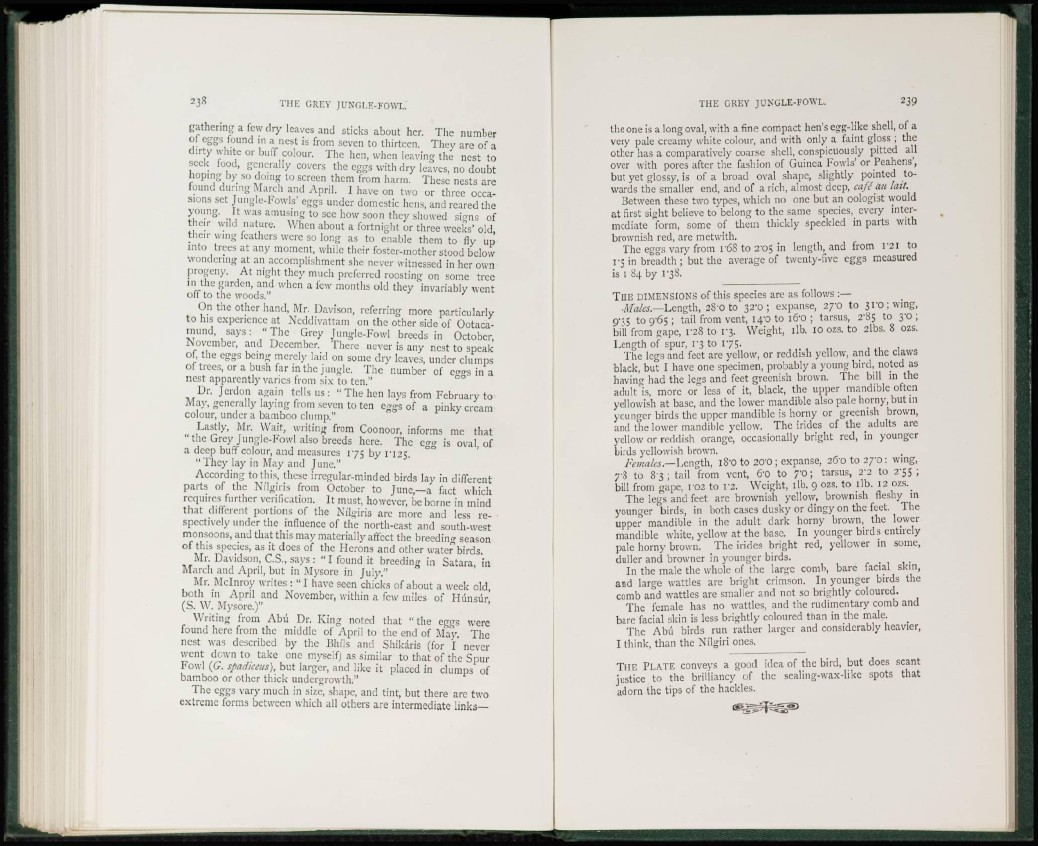
gathering a few dry leaves and sticks about her. The number
of eggs found in a nest is from seven to thirteen. They are of a
dirty white or buff colour. The hen, when leaving the nest to
seek food, generally covers the eggs with dry leaves, no doubt
hoping by so doing to screen them from harm. These nests are
found during March and April. I have on two or three occasions
set Jungle-Fowls' eggs under domestic hens, and reared the
young. It was amusing to sec how soon they showed signs of
their wild nature. When about a fortnight or three weeks' old,
their wing feathers were so long as to enable them to fly up
into trees at any moment, while their foster-mother stood below
wondering at an accomplishment she never witnessed in her own
progeny. At night they much preferred roosting on some tree
in the garden, and when a few months old they invariably went
off to the woods."
On the other hand, Mr. Davison, referring more particularly
to his experience at Ncddivattam on the other side of Ootacamund,
says: " The Grey Jungle-Fowl breeds in October,
November, and December. There never is any nest to speak
of, the eggs being merely laid on some dry leaves, under clumps
of trees, or a bush far in the jungle. The number of eggs in a
nest apparently varies from six to ten."
Dr. Jerdon again tells us : " The hen lays from February to
May, generally laying from seven to ten eggs of a pinky cream
colour, under a bamboo clump."
Lastly, Mr. Waif, writing from Coonoor, informs me that
" the Grey Jungle-Fowl also breeds here. The egg is oval, of
a deep buff colour, and measures 175 by ri25.
" They lay in May and June."
According to this, these irregular-minded birds lay in different
parts of the Ni'lgiris from October to June,—a fact which
requires further verification. It must, however, be borne in mind
that different portions of the Nilgiris are more and less respectively
under the influence of the north-cast and south-west
monsoons, and that this may materially affect the breeding season
of this species, as it does of the Flerons and other water birds.
Mr. Davidson, C.S., says : " I found it breeding in Satara, in
March and April, but in Mysore in July."
Mr. Mclnroy writes : " I have seen chicks of about a week old,
both in April and November, within a few miles of Hunsiir,
(S. W. Mysore.)"
Writing from Abu Dr. King noted that " the eggs were
found here from the middle of April to the end of May. The
nest was described by the Bhi'ls and Shikaris (for I never
went down to take one myself) as similar to that of the Spur
Fowl (G. spadiceus), but larger, and like it placed in clumps of
bamboo or other thick undergrowth;"
The eggs vary much in size, shape, and tint, but there arc two
extreme forms between which all others are intermediate links—
the one is a long oval, with a fine compact hen's egg-like shell, of a
very pale creamy white colour, and with only a faint gloss ; the
other has a comparatively coarse shell, conspicuously pitted all
over with pores after the fashion of Guinea Fowls' or Peahens',
but yet glossy, is of a broad oval shape, slightly pointed towards
the smaller end, and of a rich, almost deep, café an /ait.
Between these two types, which no one but an oologist would
at first sight believe to belong to the same species, every intermediate
form, some of them thickly speckled in parts with
brownish red, are metwith.
The eggs vary from rCS to 2'05 in length, and from I'2I to
I'5 in breadth ; but the average of twenty-five eggs measured
is 1 84 by I '38.
THE DIMENSIONS of this species are as follows :—
•Males.—Length, 280 to 32-0; expanse, 27'0 to 3 r o ; wing,
9'35 to 9'65 ; tail from vent, 14^0 to lG'O ; tarsus, 2'85 to 3'0 ;
bill from gape, l-28 to 1/3. Weight, lib. 10 ozs. to 2lbs. 8 ozs.
Length of spur, i'3 to 175.
The legs and feet are yellow, or reddish yellow, and the claws
black, but I have one specimen, probably a young bird, noted as
having had the legs and feet greenish brown. The bill in the
adult is, more or less of it, black, the upper mandible often
yellowish at base, and the lower mandible also pale horny, but in
younger birds the upper mandible is horny or greenish brown,
and the lower mandible yellow. The irides of the adults are
yellow or reddish orange, occasionally bright red, in younger
birds yellowish brown.
Females.—Length, 18'0 to 2CO ; expanse, 26'0 to 27"0: wing,
7'8 to 83; tail from vent, 6'0 to 7'0; tarsus, 2'2 to 2-5 5 ;
bill from gape, 102 to ra. Weight, lib. 9 ozs. to lib. 12 ozs.
The legs and feet are brownish yellow, brownish fleshy in
younger birds, in both cases dusky or dingy on the feet. The
upper mandible in the adult dark horny brown, the lower
mandible white, yellow at the base. In younger birds entirely
pale horny brown. The irides bright red, yellower in some,
duller and browner in younger birds.
In the male the whole of the large comb, bare facial skin,
and large wattles are bright crimson. In younger birds the
comb and wattles are smaller and not so brightly coloured.
The female has no wattles, and the rudimentary comb and
bare facial skin is less brightly coloured than in the male.
The Abu birds run rather larger and considerably heavier,
I think, than the Nilgiri ones.
T H E PLATE conveys a good idea of the bird, but does scant
justice to the brilliancy of the sealing-wax-like spots that
adorn the tips of the hackles.